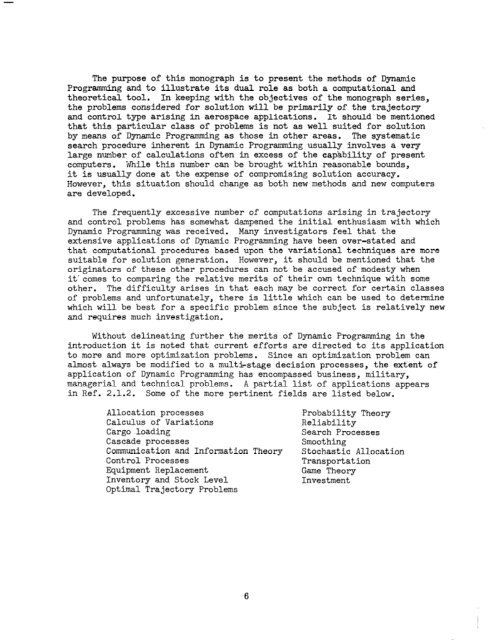guidance, flight mechanics and trajectory optimization
guidance, flight mechanics and trajectory optimization
guidance, flight mechanics and trajectory optimization
Create successful ePaper yourself
Turn your PDF publications into a flip-book with our unique Google optimized e-Paper software.
The purpose of this monograph is to present the methods of Dynamic<br />
Programmin g <strong>and</strong> to illustrate its dual role as both a computational <strong>and</strong><br />
theoretical tool. In keeping with the objectives of the monograph series,<br />
the problems considered for solution will be primarily of the <strong>trajectory</strong><br />
<strong>and</strong> control type arising in aerospace applications. It should be mentioned<br />
that this particular class of problems is not as well suited for solution<br />
by means of Dynamic Programming as those in other areas. The systematic<br />
search procedure inherent in Dynamic Programming usually involves a very<br />
large number of calculations often in excess of the capability of present<br />
computers. While this number can be brought within reasonable bounds,<br />
it is usually done at the expense of compromising solution accuracy.<br />
However, this situation should change as both new methods <strong>and</strong> new computers<br />
are developed.<br />
The frequently excessive number of computations arising in <strong>trajectory</strong><br />
<strong>and</strong> control problems has somewhat dampened the initial enthusiasm with which<br />
Dynamic Programming was received. Many investigators feel that the<br />
extensive applications of Dynamic Programming have been over-stated <strong>and</strong><br />
that computational procedures based upon the variational techniques are more<br />
suitable for solution generation. However, it should be mentioned that the<br />
originators of these other procedures can not be accused of modesty when<br />
it'comes to comparing the relative merits of their own technique with some<br />
other. The difficulty arises in that each may be correct for certain classes<br />
of problems <strong>and</strong> unfortunately, there is little which can be used to determine<br />
which will be best for a specific problem since the subject is relatively new<br />
<strong>and</strong> requires much investigation.<br />
Without delineating further the merits of Dynamic Programming in the<br />
introduction it is noted that current efforts are directed to its application<br />
to more <strong>and</strong> more <strong>optimization</strong> problems. Since an <strong>optimization</strong> problem can<br />
almost always be modified to a multi-stage decision processes, the extent of<br />
application of Dynamic Programming has encompassed business, military,<br />
managerial <strong>and</strong> technical problems. A partial list of applications appears<br />
in Ref. 2.1.2. Some of the more pertinent fields are listed below.<br />
Allocation processes<br />
Calculus of Variations<br />
Cargo loading<br />
Cascade processes<br />
Communication <strong>and</strong> Information Theory<br />
Control Processes<br />
Equipment Replacement<br />
Inventory <strong>and</strong> Stock Level<br />
Optimal Trajectory Problems<br />
6<br />
Probability Theory<br />
Reliability<br />
Search Processes<br />
Smoothing<br />
Stochastic Allocation<br />
Transportation<br />
Game Theory<br />
Investment

















